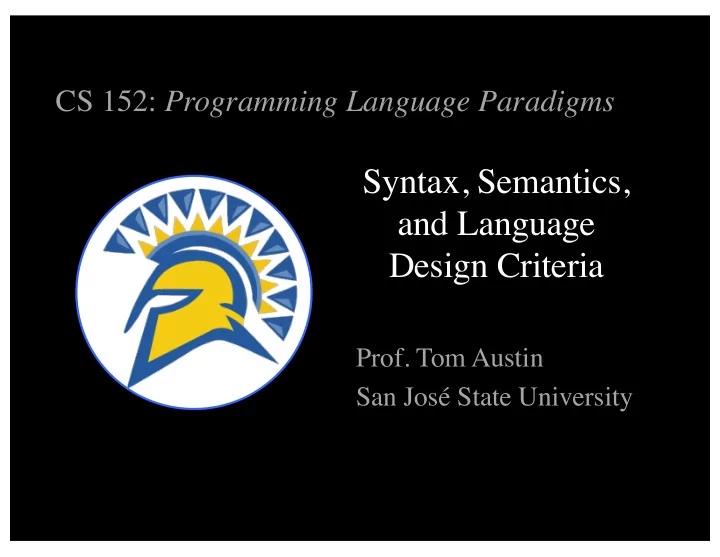

CS 152: Programming Language Paradigms Syntax, Semantics, and Language Design Criteria Prof. Tom Austin San José State University
Lab 1 solution (in class)
Formally defining a language Two aspects of a language: • Syntax – structure of a program • Semantics – meaning of a program
The two parts of syntax • Lexemes or tokens – the "words" of the language • Grammar – the way that words can be ordered
How a compiler works Lexer/ source tokens … code Tokenizer Tokens are the "words" of the language.
How a compiler works if (x < 42) { y++; Lexer/ source tokens } else { code Tokenizer "if" "(" "x" "<" y = 42; "42" ")" "{" "y" } "++" ";" "}" "else" "{" "y" "=" "42" ";" "}" Tokens are the "words" of the language.
How a compiler works if (x < 42) { y++; Lexer/ source tokens } else { code Tokenizer "if" "(" "x" "<" y = 42; "42" ")" "{" "y" } "++" ";" "}" "else" "{" "y" "=" "42" ";" "}" Types of tokens: • Identifiers • Numbers • Reserved words • Special characters
How a compiler works Lexer/ source tokens Parser code Tokenizer The parser reads Abstract tokens to form an Syntax Tree abstract syntax tree. (AST)
Parsing Example if "if" "(" "x" "<" "42" ")" "{" "y" Parser "++" ";" "}" < = = "else" "{" "y" "=" "42" ";" "}" 42 X y + y 42 y++ has disappeared in the AST. '++' is an example of 1 y syntactic sugar.
Formally defining language syntax Context-free grammars define the structure of a language. Backas-Naur Form (BNF) is a common notation.
Context-free grammar for math expressions (in BNF notation) <expr> -> <expr> + <term> | <expr> - <term> | <term> <term> -> <term> * <factor> | <term> / <factor> | <factor>
How a compiler works Lexer/ source tokens Parser code Tokenizer Abstract Compiler Interpreter Syntax Tree (AST) Machine code Commands
Compilers and interpreters derive meaning from ASTs to turn programs into actions. Covered another day Formally defining language meaning: • Operational semantics • Denotational semantics • Axiomatic semantics
Judging a language
Louden & Lambert's Design Criteria 1. Efficiency 2. Regularity 3. Security 4. Extensibility
Efficiency • Machine efficiency – tips to the compiler • Programmer efficiency – ease of writing programs – expressiveness (conciseness helps) • Reliability – code maintenance
Efficiency Java: Python: int i = 10; i = 10 String s = "hi"; s = "hi" • Machine efficiency: Java offers tips to the compiler • Programmer efficiency: Python reduces the amount of typing required
Regularity • Generality: – avoid special cases – favor general constructs • Orthogonal design: – different constructs can be combined with no unexpected restrictions • Uniformity – similar things look similar – different things look different
Bad uniformity example (PHP): Same things look different Inconsistent function naming: • isset() • is_null() • strip_tags() • stripslashes()
Bad uniformity example (Pascal): Different things look the same function f : boolean; begin ... Return value is true f := true; end;
Security • Stop programmer errors – or handle them gracefully • Strong typing prevents some run-time errors. • Semantically-safe languages – stop executing code violating language definition – Contrast array handling by Java and by C/C++
Safety (Java vs. Scheme) Java: Scheme: int x = 4; (let ([x 4] boolean b = true; [b #t]) if (b) { (if b x++; (+ 1 x) } else { (/ x "2"))) x = x / "2"; }
Extensibility Allows the programmer to add new language constructs easily. Macros in Scheme are an example.
Before next class Read Chapter 6 of Teach Yourself Scheme .
Lab 2: More Scheme practice • Download lab2.rkt from the course website – Implement reverse function – Implement add-two-lists – Implement positive-nums-only • Using Louden & Lambert's criteria, compare Java & Scheme (or two languages of your choice)
Recommend
More recommend